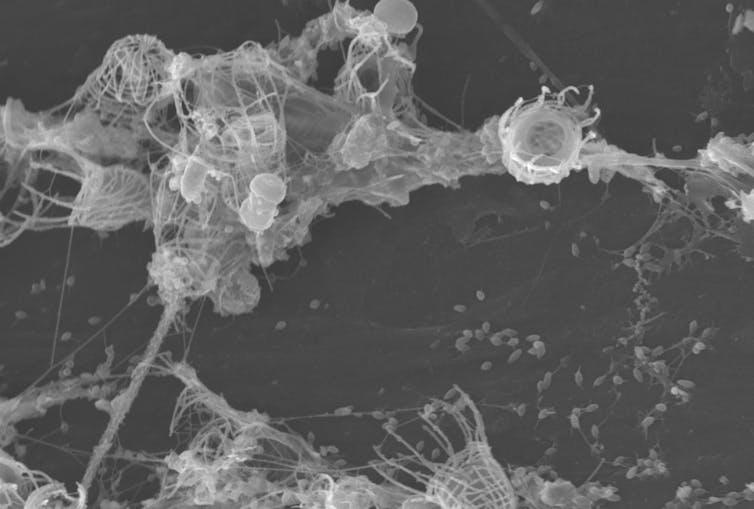Antarctica, the world’s most remote, harsh and ancient continent, is not free from marine pollution. Wherever there is human activity, plastic debris inevitably appears.
What might the early explorers of this icy wilderness think today, upon discovering a continent transformed by sustainable fishing activities, research stations, military presence, tourism and all their environmental impacts? Among these, plastic pollution is prominent, as it has created a unique new ecological niche in the ocean.
Once it gets into the water, plastic debris provides a surface on which microbial communities can quickly settle, forming a biofilm. This plastic-generated community is known as the plastosphere, and it poses a serious threat to marine ecosystems, particularly in the cold, less-studied waters of the Southern Ocean.
Plastisphere: an emerging threat
As plastic debris flows into the ocean, the plastisphere evolves through specific ecological succession, eventually becoming a complex and distinct microbial community. Plastic not only provides shelter to these microorganisms, but also acts as a vector, allowing potentially harmful pathogens Vibrio spp., Escherichia coliAnd bacteria carrying antibiotic-resistant genes spread in the marine environment, even reaching remote, untouched areas.
In addition to being home to microbes, the plastosphere can disrupt the natural balance of marine life on a microscopic level. These changes do not stay in the water, as they can spread outward, potentially affecting how the ocean absorbs carbon and produces greenhouse gases. This has consequences for the air we breathe around the world.
However, it’s not all bad news, as bacteria are known for their ability to degrade plastics or hydrocarbons – such as Alcanivorax SP, estuariella SP, marinobacter S.P. And alteromonas S.P. – Often identified on plastic.

a hostile research environment
We currently know very little about the plastosphere, particularly in the Southern Ocean, where uncovering its dynamics is critical to understanding its impacts on one of the planet’s most remote and vulnerable marine environments. For this reason, our recent study sought to investigate the abundance and diversity of microbial communities in the plastosphere of the Southern Ocean, particularly after initial colonization by plastic debris.
Working in Antarctica is not an easy task. Reaching the continent is a challenge, and once there, scientists must contend with harsh environmental conditions: freezing temperatures, powerful winds, icebergs, and the constant pressure of limited time to do their work. These challenges make every moment in the field demanding and precious.
That is why we approached our study with a controlled and manageable experiment. We set up aquariums filled with seawater collected near the Spanish research station on Livingston Island, South Shetland. Inside, we placed small, round pellets of the three most common types of plastic that pollute the ocean – polyethylene, polypropylene and polystyrene. We left them in environmental conditions (between approximately 0 ºC and 13 – 18 hours of sunlight) for 5 weeks, aiming to recreate the most plausible results in the field.
We compared the colonization of plastic with that of glass, an inert surface. Plastic and glass samples were collected periodically to detect bacterial colonization.
Plastisphere dynamics in Antarctica
Studying bacteria means making the invisible visible, so we combined several techniques to get a better picture of the plastisphere. Using scanning electron microscopy, we obtained biofilm images. We combined flow cytometry and bacterial culture to count total cells and colonies, and we sequenced the 16S rRNA gene to identify the succession of bacterial settlers.
This nuanced approach revealed that time was the key driver of change. Microorganisms quickly took over the plastic, and in less than two days a bacterial genus of Colwellia were already stable on the surface, showing clear progression from early settlers to mature diverse biofilms including other genera such as Sulfitobacter, glycicola Or Lavinella,
These species, although also found in water, show a clear preference for the social life of the biofilm community. Furthermore, we did not find clear differences between bacterial communities from plastic and glass, suggesting that any stable surface can host these communities.
While similar processes occur in other oceans, the process appears to be slower in Antarctica. The low temperature of the area slows the growth of bacteria.
Bacteria eating plastic?
A major discovery was the presence of olispira S.P. On polypropylene. This bacteria is hydrocarbon-degrading, which means it belongs to a group of microorganisms that can break down oil and other pollutants.
Their role within the Antarctic plastosphere raises important questions, such as whether these types of bacteria can mitigate the effects of plastic pollution. If so, they may hold the key to the future of Antarctica and our oceans.
However, much still remains to be discovered, especially with regard to their potential for bioremediation in extreme environments. Understanding these processes may lead to innovative strategies to address the growing challenge of plastic waste in marine ecosystems.![]()
,Author: Pere Monras i Riera, Investigador Predoctoral en Conservation y Gestión de la Biodiversidad, Universitat de Barcelona and Elisenda Balleste, Professor Aggregada en Microbiologia, Universitat de Barcelona)
,disclosure statement: Pere Monràs i Riera receives funding from the University of Barcelona. Elisenda Balleste receives funding from the Spanish Ministry of Science and Innovation)
This article is republished from The Conversation under a Creative Commons license. Read the original article.
(Except for the headline, this story has not been edited by NDTV staff and is published from a syndicated feed.)





